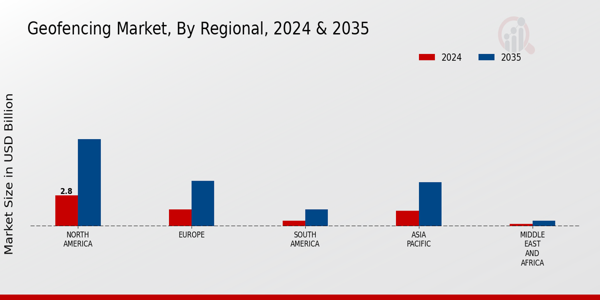Market Growth Projections
The Global Geofencing Market Industry is projected to experience substantial growth in the coming years. With a market size of 6.4 USD Billion in 2024, the industry is expected to expand significantly, reaching 18 USD Billion by 2035. This growth trajectory indicates a compound annual growth rate of 9.86% from 2025 to 2035. Factors contributing to this growth include the increasing adoption of location-based services, advancements in mobile technology, and the integration of artificial intelligence. As businesses continue to recognize the value of geofencing in enhancing customer engagement and driving sales, the market is poised for a robust expansion.
Advancements in Mobile Technology
The Global Geofencing Market Industry is significantly influenced by advancements in mobile technology. With the proliferation of smartphones and GPS-enabled devices, businesses can implement geofencing solutions more effectively. Enhanced mobile capabilities allow for real-time tracking and location-based notifications, which are crucial for effective marketing strategies. As mobile technology continues to evolve, it is anticipated that the market will expand, potentially reaching 18 USD Billion by 2035. This growth may be driven by the increasing integration of geofencing with mobile applications, enabling businesses to create more immersive and interactive customer experiences within the Global Geofencing Market Industry.
Integration of Artificial Intelligence
The integration of artificial intelligence (AI) into geofencing solutions is emerging as a pivotal driver for the Global Geofencing Market Industry. AI enhances the capabilities of geofencing by enabling predictive analytics and automated decision-making processes. Businesses can analyze customer behavior patterns and optimize their marketing strategies accordingly. This technological synergy is expected to lead to more effective targeting and improved customer experiences. As AI continues to evolve, its application in geofencing is likely to expand, further stimulating market growth. The Global Geofencing Market Industry may see substantial advancements as organizations leverage AI to refine their geofencing strategies.
Increasing Adoption of Location-Based Services
The Global Geofencing Market Industry is experiencing a surge in the adoption of location-based services across various sectors. Businesses are increasingly leveraging geofencing technology to enhance customer engagement and drive sales. For instance, retailers utilize geofencing to send targeted promotions to customers' mobile devices when they enter a specific geographic area. This trend is expected to contribute to the market's growth, with projections indicating a market size of 6.4 USD Billion in 2024. As companies recognize the potential of personalized marketing strategies, the demand for geofencing solutions is likely to rise, fostering a competitive landscape in the Global Geofencing Market Industry.
Regulatory Support for Location-Based Services
Regulatory support for location-based services is playing a crucial role in shaping the Global Geofencing Market Industry. Governments are increasingly recognizing the economic potential of geofencing technologies and are implementing policies to encourage their adoption. This support may include initiatives aimed at promoting data privacy and security, which are essential for consumer trust. As regulations evolve, businesses are likely to feel more confident in investing in geofencing solutions. This regulatory landscape could facilitate market growth, contributing to the anticipated increase in market size to 18 USD Billion by 2035. The Global Geofencing Market Industry stands to benefit from a favorable regulatory environment.
Rising Demand for Enhanced Customer Engagement
The Global Geofencing Market Industry is witnessing a rising demand for enhanced customer engagement strategies. Companies are increasingly recognizing the importance of personalized interactions to foster brand loyalty and drive sales. Geofencing technology allows businesses to send tailored messages and offers to customers based on their location, thereby increasing the likelihood of conversion. This trend is expected to propel the market forward, with a projected compound annual growth rate of 9.86% from 2025 to 2035. As organizations strive to create more meaningful connections with their customers, the adoption of geofencing solutions is likely to become a critical component of their marketing strategies within the Global Geofencing Market Industry.





















